 Package Modelica.Magnetic.QuasiStatic.FundamentalWave.Components
Package Modelica.Magnetic.QuasiStatic.FundamentalWave.ComponentsBasic fundamental wave components
 Package Modelica.Magnetic.QuasiStatic.FundamentalWave.Components
Package Modelica.Magnetic.QuasiStatic.FundamentalWave.Components
Basic components of the FundamentalWave library for modeling magnetic circuits. Machine specific components are located at Machines.Components.
Extends from Modelica.Icons.Package (Icon for standard packages).
| Name | Description |
|---|---|
Crossing | Crossing of connections |
EddyCurrent | Constant loss model under sinusoidal magnetic conditions |
Ground | Magnetic ground |
Idle | Idle running branch |
MultiPhaseElectroMagneticConverter | Multi phase electro magnetic converter |
Permeance | Salient Permeance |
QuasiStaticAnalogElectroMagneticConverter | Electro magnetic converter to only (!) quasi static analog, neglecting induced voltage |
Reluctance | Salient reluctance |
Short | Short connection |
 Model Modelica.Magnetic.QuasiStatic.FundamentalWave.Components.Ground
Model Modelica.Magnetic.QuasiStatic.FundamentalWave.Components.Ground
Grounding of the complex magnetic potential. Each magnetic circuit has to be grounded at least one point of the circuit.
| Type | Name | Description |
|---|---|---|
PositiveMagneticPort | port_p | Complex magnetic port |
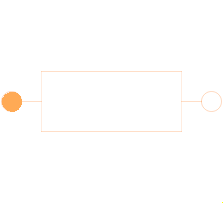 Model Modelica.Magnetic.QuasiStatic.FundamentalWave.Components.Reluctance
Model Modelica.Magnetic.QuasiStatic.FundamentalWave.Components.Reluctance
The salient reluctance models the relationship between the complex magnetic potential difference
 and the complex magnetic flux
and the complex magnetic flux  ,
,

which can also be expressed in terms complex phasors:

Extends from Modelica.Magnetic.QuasiStatic.FundamentalWave.Interfaces.PartialTwoPortElementary (Elementary partial two port for textual programming).
| Type | Name | Default | Description |
|---|---|---|---|
SalientReluctance | R_m | Magnetic reluctance in d=re and q=im axis |
| Type | Name | Description |
|---|---|---|
PositiveMagneticPort | port_p | Positive quasi-static magnetic port of fundamental wave machines |
NegativeMagneticPort | port_n | Negative quasi-static magnetic port of fundamental wave machines |
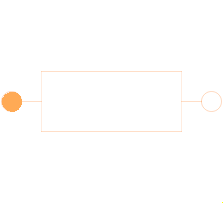 Model Modelica.Magnetic.QuasiStatic.FundamentalWave.Components.Permeance
Model Modelica.Magnetic.QuasiStatic.FundamentalWave.Components.Permeance
The salient permeance models the relationship between the complex magnetic potential difference
 and the complex magnetic flux
and the complex magnetic flux  :
:
Extends from Modelica.Magnetic.QuasiStatic.FundamentalWave.Interfaces.PartialTwoPortElementary (Elementary partial two port for textual programming).
| Type | Name | Default | Description |
|---|---|---|---|
SalientPermeance | G_m | Magnetic permeance in d=re and q=im axis |
| Type | Name | Description |
|---|---|---|
PositiveMagneticPort | port_p | Positive quasi-static magnetic port of fundamental wave machines |
NegativeMagneticPort | port_n | Negative quasi-static magnetic port of fundamental wave machines |
 Model Modelica.Magnetic.QuasiStatic.FundamentalWave.Components.EddyCurrent
Model Modelica.Magnetic.QuasiStatic.FundamentalWave.Components.EddyCurrent
The eddy current loss model with respect to fundamental wave effects is designed in accordance to FluxTubes.Basic.EddyCurrent and FundamentalWave.Components.EddyCurrent.
 .
.
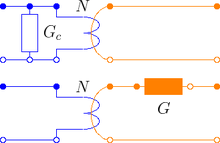
|
Due to the nature of eddy current losses, which can be represented by symmetric
conductors in an equivalent electric circuit (Fig. 1), the respective
number of phases  has to be taken into account.
Assume that the
has to be taken into account.
Assume that the  conductances
of the equivalent circuit are
conductances
of the equivalent circuit are  ,
the conductance for the eddy current loss model is determined by
,
the conductance for the eddy current loss model is determined by

where  is the number of turns of the symmetric electro magnetic coupling.
is the number of turns of the symmetric electro magnetic coupling.
For such an  phase system
the relationship between the voltage and current space phasors
and the magnetic flux and magnetic potential difference phasor is
phase system
the relationship between the voltage and current space phasors
and the magnetic flux and magnetic potential difference phasor is
 ,
,
 ,
,
where  and
and  are the phase voltages and currents, respectively.
are the phase voltages and currents, respectively.
The dissipated loss power

can be determined for the space phasor relationship of the voltage and current space phasor.
Extends from Modelica.Magnetic.QuasiStatic.FundamentalWave.Interfaces.PartialTwoPortElementary (Elementary partial two port for textual programming) and Modelica.Thermal.HeatTransfer.Interfaces.PartialElementaryConditionalHeatPort (Partial model to include a conditional HeatPort in order to dissipate losses, used for textual modeling, i.e., for elementary models).
| Type | Name | Default | Description |
|---|---|---|---|
Conductance | G | Equivalent symmetric loss conductance | |
Boolean | useHeatPort | false | =true, if heatPort is enabled |
final Temperature | T | 273.15 | Fixed device temperature if useHeatPort = false |
| Type | Name | Description |
|---|---|---|
PositiveMagneticPort | port_p | Positive quasi-static magnetic port of fundamental wave machines |
NegativeMagneticPort | port_n | Negative quasi-static magnetic port of fundamental wave machines |
HeatPort_a | heatPort | Optional port to which dissipated losses are transported in form of heat |
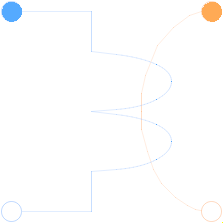 Model Modelica.Magnetic.QuasiStatic.FundamentalWave.Components.MultiPhaseElectroMagneticConverter
Model Modelica.Magnetic.QuasiStatic.FundamentalWave.Components.MultiPhaseElectroMagneticConverter
Each phase  of an
of an  phase winding has an effective number of turns,
phase winding has an effective number of turns,  and an respective winging angle
and an respective winging angle  and a phase current
and a phase current  .
.
The total complex magnetic potential difference of the multi phase winding is determined by:

In this equation
 is the positive symmetrical component of the currents.
is the positive symmetrical component of the currents.
The positive sequence of the voltages
 induced in each winding is directly proportional to the complex magnetic flux and the number of turns. This relationship can be modeled by means of
induced in each winding is directly proportional to the complex magnetic flux and the number of turns. This relationship can be modeled by means of
 .
.
Modelica.Magnetic.FundamentalWave.Components.SinglePhaseElectroMagneticConverter, Modelica.Magnetic.FundamentalWave.Components.MultiPhaseElectroMagneticConverter, QuasiStaticAnalogElectroMagneticConverter
| Type | Name | Default | Description |
|---|---|---|---|
Integer | m | 3 | Number of phases |
Real | effectiveTurns | Effective number of turns | |
final Complex | N | effectiveTurns * Modelica.ComplexMath.exp(Complex(0, orientation)) | Complex effective number of turns |
| Type | Name | Description |
|---|---|---|
PositivePlug | plug_p | Positive plug |
NegativePlug | plug_n | Negative plug |
PositiveMagneticPort | port_p | Positive complex magnetic port |
NegativeMagneticPort | port_n | Negative complex magnetic port |
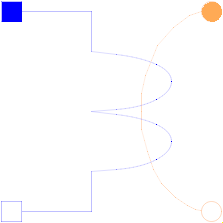 Model Modelica.Magnetic.QuasiStatic.FundamentalWave.Components.QuasiStaticAnalogElectroMagneticConverter
Model Modelica.Magnetic.QuasiStatic.FundamentalWave.Components.QuasiStaticAnalogElectroMagneticConverter
The analog single phase winding has an effective number of turns,  and a respective orientation of the winding,
and a respective orientation of the winding,  . The current in the winding is
. The current in the winding is  .
.
The total complex magnetic potential difference of the single phase winding is determined by:

where
 is the reference angle of the electrical and magnetic system, respectively. The induced voltage
is the reference angle of the electrical and magnetic system, respectively. The induced voltage  is identical to zero.
is identical to zero.
Modelica.Magnetic.FundamentalWave.Components.SinglePhaseElectroMagneticConverter, Modelica.Magnetic.FundamentalWave.Components.MultiPhaseElectroMagneticConverter, MultiPhaseElectroMagneticConverter
| Type | Name | Default | Description |
|---|---|---|---|
Real | effectiveTurns | Effective number of turns |
| Type | Name | Description |
|---|---|---|
PositivePin | pin_p | Positive pin |
NegativePin | pin_n | Negative pin |
PositiveMagneticPort | port_p | Positive complex magnetic port |
NegativeMagneticPort | port_n | Negative complex magnetic port |
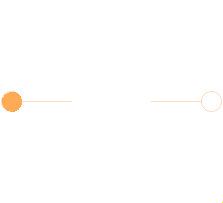 Model Modelica.Magnetic.QuasiStatic.FundamentalWave.Components.Idle
Model Modelica.Magnetic.QuasiStatic.FundamentalWave.Components.Idle
This is a simple idle running branch.
Short Crossing, Magnetic.FundamentalWave.Components.Idle, Magnetic.FundamentalWave.Components.Short, Magnetic.FundamentalWave.Components.Crossing
Extends from Modelica.Magnetic.QuasiStatic.FundamentalWave.Interfaces.PartialTwoPortElementary (Elementary partial two port for textual programming).
| Type | Name | Description |
|---|---|---|
PositiveMagneticPort | port_p | Positive quasi-static magnetic port of fundamental wave machines |
NegativeMagneticPort | port_n | Negative quasi-static magnetic port of fundamental wave machines |
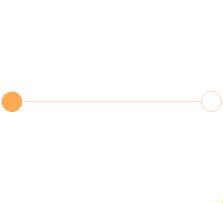 Model Modelica.Magnetic.QuasiStatic.FundamentalWave.Components.Short
Model Modelica.Magnetic.QuasiStatic.FundamentalWave.Components.Short
This is a simple short cut branch.
Idle Crossing, Magnetic.FundamentalWave.Components.Idle, Magnetic.FundamentalWave.Components.Short, Magnetic.FundamentalWave.Components.Crossing
Extends from Modelica.Magnetic.QuasiStatic.FundamentalWave.Interfaces.PartialTwoPort (Partial two port for graphical programming).
| Type | Name | Description |
|---|---|---|
PositiveMagneticPort | port_p | Positive quasi-static magnetic port of fundamental wave machines |
NegativeMagneticPort | port_n | Negative quasi-static magnetic port of fundamental wave machines |
 Model Modelica.Magnetic.QuasiStatic.FundamentalWave.Components.Crossing
Model Modelica.Magnetic.QuasiStatic.FundamentalWave.Components.Crossing
This is a simple short cut branch.
Idle Short Magnetic.FundamentalWave.Components.Idle, Magnetic.FundamentalWave.Components.Short, Magnetic.FundamentalWave.Components.Crossing
| Type | Name | Description |
|---|---|---|
PositiveMagneticPort | port_p1 | Connected with port_p2 |
NegativeMagneticPort | port_n1 | Connected with port_n2 |
PositiveMagneticPort | port_p2 | Connected with port_p1 |
NegativeMagneticPort | port_n2 | Connected with port_n1 |